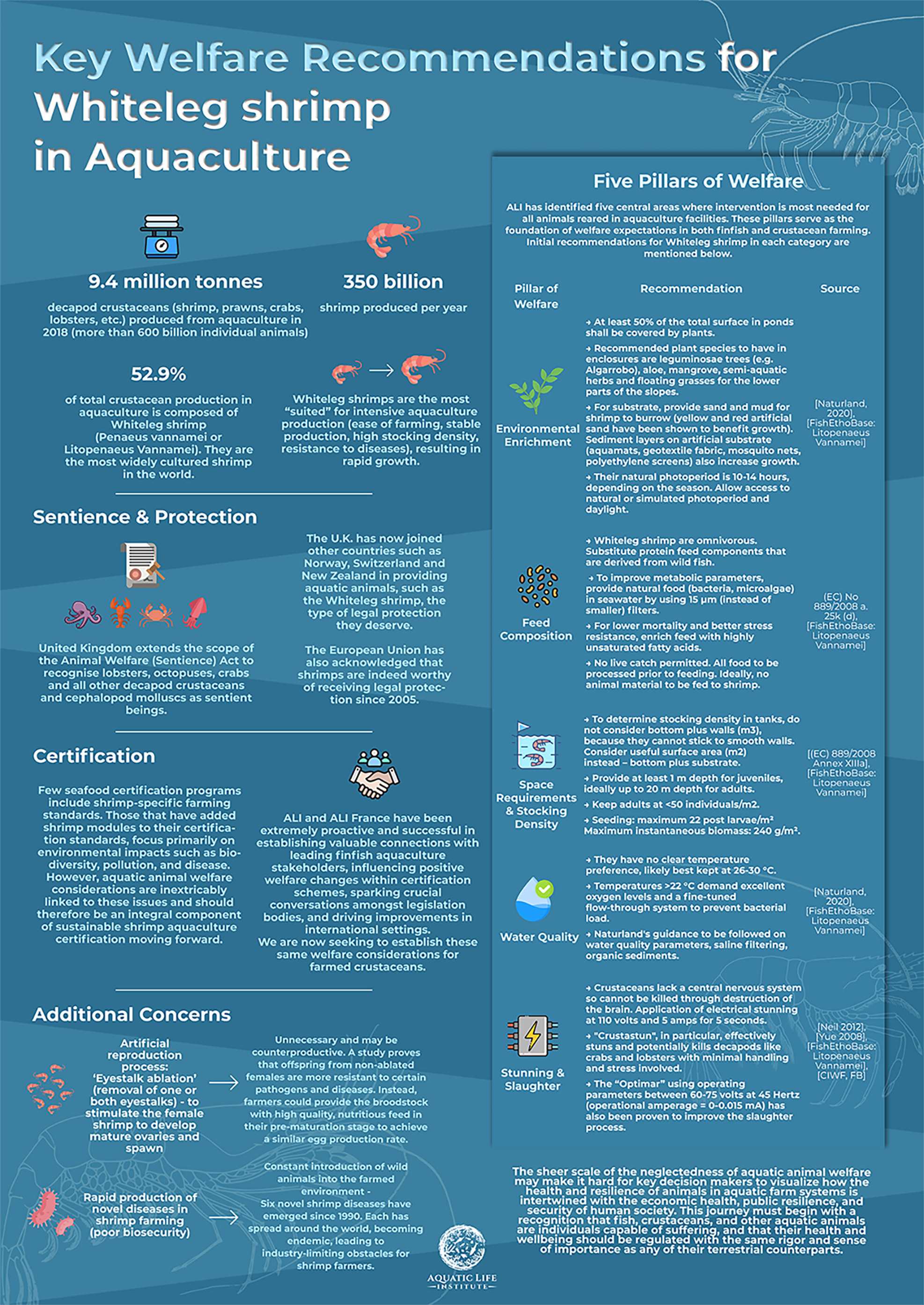Key Welfare Recommendations for Whiteleg Shrimp in Aquaculture
Crustacean aquaculture has grown dramatically over the past 20 years. In 2018, 9.4 million tonnes of decapod crustaceans were produced from aquaculture, which could translate to more than 600 billion individual animals. Very few seafood certification programs include crustacean-specific farming standards so we are seeking to establish welfare considerations for farmed crustaceans, using the 5 pillars of welfare discussed in our Welfare Guide. Four of the most influential certification schemes have incorporated our recommendations into their revised/pending aquaculture guidelines. Our success related to finfish aquaculture certification will pave the way for future welfare improvements in crustacean aquaculture. This work starts by engaging with international certification programs to consider, research, and implement crustacean-specific welfare practices.
References
“FIGIS - Time-Series Query On: Aquaculture.” Www.fao.org, www.fao.org/figis/servlet/SQServlet?file=/usr/local/tomcat/8.5.16/figis/webapps/figis/temp/hqp_307522612789908332.xml&outtype=html
“Numbers of Farmed Decapod Crustaceans | Fishcount.org.uk.” Fishcount.org.uk, fishcount.org.uk/fish-count-estimates-2/numbers-of-farmed-decapod-crustaceans
"Shrimp Welfare Project: Home." https://www.shrimpwelfareproject.org/.
FAO. The State of World Fisheries and Aquaculture 2020. FAO, 2020.
H S Suwoyo and E A Hendrajat 2021 IOP Conf. Ser.: Earth Environ. Sci. 777 012022
“Lobsters, octopus and crabs recognised as sentient beings - GOV.UK." 19 Nov. 2021, https://www.gov.uk/government/news/lobsters-octopus-and-crabs-recognised-as-sentient-beings.
Birch, Jonathan, et al. Review of the Evidence of Sentience in Cephalopod Molluscs and Decapod Crustaceans. 2021.
“Opinion of the Scientific Panel on Animal Health and Welfare (AHAW) on a Request from the Commission Related to the Aspects of the Biology and Welfare of Animals Used for Experimental and Other Scientific Purposes.” EFSA Journal, vol. 3, no. 12, Dec. 2005, p. 292, 10.2903/j.efsa.2005.292.
Benefits of Aquatic Animal Welfare for Sustainability: https://ali.fish/aquatic-animal-welfare-sustainability
Key Aquatic Animal Welfare Recommendations for Aquaculture: https://ali.fish/aquaculture-welfare-guide
Volstorf, Jenny and Ana Roque. 2019. Litopenaeus vannamei (Recommendations). In: FishEthoBase, ed. Fish Ethology and Welfare Group. World Wide Web electronic publication. Version 1.84. www.fishethobase.net
"Electrical stunning of crustaceans | fishcount.org.uk." http://fishcount.org.uk/welfare-of-crustaceans/electrical-stunning.
“Tesco and Hilton Seafood – Improving the welfare of whiteleg ...." https://www.compassioninfoodbusiness.com/media/7444897/tesco-and-hilton-seafood-case-study-improving-the-welfare-of-whiteleg-shrimp-at-harvest.pdf.
Zacarias, Simão, et al. “Increased Robustness of Postlarvae and Juveniles from Non-Ablated Pacific Whiteleg Shrimp, Penaeus Vannamei, Broodstock Post-Challenged with Pathogenic Isolates of Vibrio Parahaemolyticus (VpAHPND) and White Spot Disease (WSD).” Aquaculture, vol. 532, Feb. 2021, p. 736033, 10.1016/j.aquaculture.2020.736033.
“Animal welfare: an asset for livestock production - OIE." https://www.oie.int/app/uploads/2021/03/bull-2017-1-eng.pdf.


